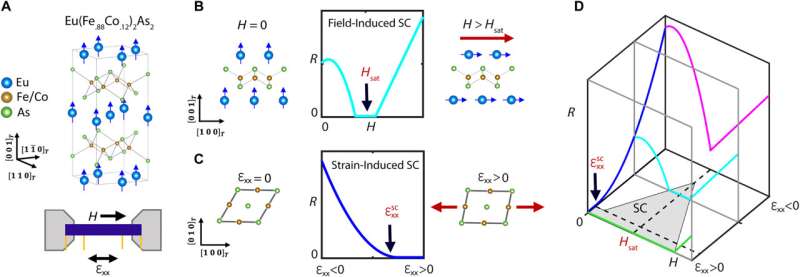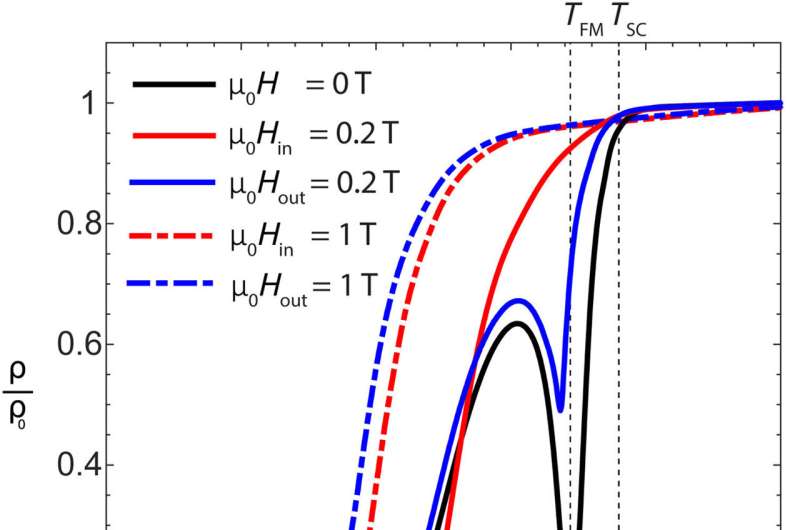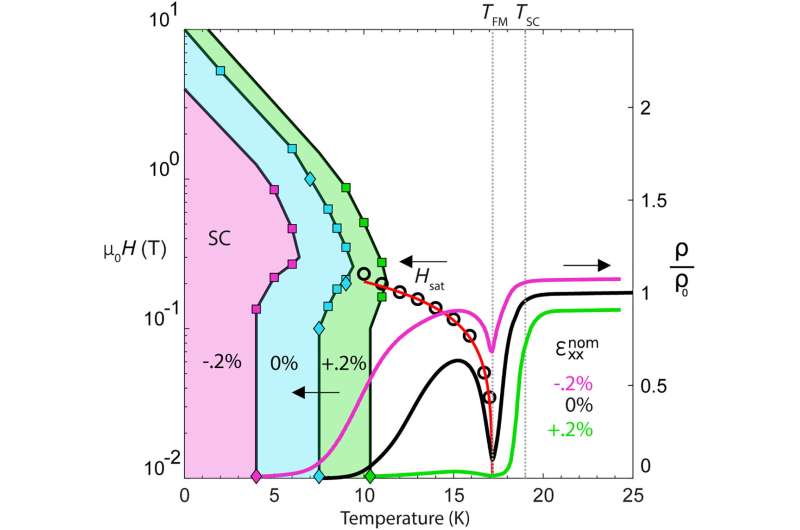December 12, 2023 feature
This article has been reviewed according to Science X's editorial process and policies. Editors have highlighted the following attributes while ensuring the content's credibility:
fact-checked
peer-reviewed publication
trusted source
proofread
Field-induced superconductivity in quantum materials

Field-induced superconductivity occurs when an applied magnetic field increases or induces superconductivity. In a new report published in Science Advances, Joshua J. Sanchez and a team of scientists applied stress as a switch between a field tunable superconducting state and a robust non-field tunable state, to mark the first demonstration of a strain-tunable, superconducting spin valve with infinite magnetoresistance.
The scientists combined tunable uniaxial stress and applied a magnetic field on the ferromagnetic superconductor to shift the field-induced zero resistance temperature. Using X-ray diffraction, and spectroscopy measurements under stress, the team proposed the origin of field-induced superconductivity to result from a new mechanism known as the dipolar fold.
Quantum materials in condensed matter physics
It is possible to switch between distinct electronic phases in quantum materials by tuning the parameters to show how they interact to drive technological development. An area of significant development includes ferromagnetism and superconductivity, whose antagonistic interactions lead to unusual phenomena including magnetic vortices, and spin-polarized supercurrents as promising methods for energy-efficient data storage.
Researchers have focused much attention on superconducting spin valves that surround a superconducting layer, for low energy dissipation information technologies. The development of such technologies can be limited by the very low temperatures required to implement them.
Aside from artificial heterostructures, a handful of single crystal materials showed field-induced superconductivity, melting doped-superconductors, and organic superconductors. In these materials and thin-film superconducting spin valves, the zero-resistance temperature is below 1 Kelvin, thereby limiting their practical applications.

Thin-film superconductance
Within these materials, and within thin-film superconducting spin valves, the zero-resistance temperature is below 1 Kelvin, which can limit their practical applications. At present, the underlying mechanisms of field-induced superconductivity remain to be determined, where the effect can enhance the temperature.
In this work, Sanchez et al. showed field-induced superconductivity in 12% co-doped superconducting materials with varying temperature, with applied uniaxial stress. The value provided the highest reported temperature of magnetic field-induced superconductivity in any material. The doped materials existed as a naturally grown thin-film superconducting spin valve architecture, with alternating ferromagnetic and superconducting layers.
The team combined the synchrotron X-ray methods with transport measurements to show strain tuning capacity and field tuning properties to exist as features of independent superconductivity.
Sanchez and colleagues combined strain tunability with high temperature and low switching fields to create an existing platform for potential superconducting spintronics applications. They further performed density functional theory calculations to highlight ferromagnetic and antiferromagnetic exchange interactions to solve the mystery of co-existing with ferromagnets.
The team intends to explore how this mechanism can be realized in other systems including two-dimensional systems.
Field-induced superconductivity
During these experiments, the scientists grew single crystals with 12% co-doped materials in tin flux and noted how the non-stoichiometric growth composition yielded samples with increased superconducting transition temperatures. They selected samples from different growth batches and prepared them identically to better compare field and strain tuning of resistivity. During the experiments, the team cooled the samples through the superconducting and ferromagnetic temperatures, respectively.

After conducting these measurements, the team mounted the sample to a uniaxial stress device to measure the resistivity and strain range. When they applied the field at fixed temperature stress, they constructed a superconductivity strain field-tunable phase diagram.
The research team noted the accessibility of the field-induced superconductivity in a temperature window under zero strain. As the temperature decreased, the increasing magnetic moment led to ferromagnetism having a larger influence on superconductivity.
Strain and magnetic field—the tuning knobs of superconductivity
To identify the independence of strain and magnetic field to tune superconductivity and resolve the mechanism of field-induced superconductivity, Sanchez and colleagues conducted transport measurements under applied strain, concurrent with X-ray diffraction or X-ray magnetic circular dichroism at the Advanced photon source. X-ray diffraction provided a powerful method to study ferromagnetic superconductors with element-specific magnetic information, under fluorescence mode.
The team then effectively strain-tuned the superconductivity through its competition with strain-tunable nematicity and the associated ferromagnetic order. The research team noted field-induced superconductivity where a narrow strain range permitted field-induced superconductivity. Thereafter, to investigate the origin of field-induced superconductivity, the researchers performed simultaneous resistivity and X-ray measurements to independently tune the parameters of superconductivity.
![Conceptual approach for a toggle switch using a strain-switchable superconducting spin valve. (A) A field-switchable current divider is created by mechanically and electrically connecting a strain-tunable superconducting spin valve (SSV, blue) to a piezo actuator (gray). (B) A current I passes through the SSV from the input (Vin) to output (Vout) voltage leads, with Vout = Vin − IR. The voltage across the piezo is ΔVp = Vout. (C) Device parameters are chosen so that an applied strain ɛxx(Vin) = ε and/or an applied field H = Hsat switches the SSV from a metallic state (M, R > 0) to a superconducting state (SC, R = 0). (D) The circuit initializes at point (a) with the SSV in the M state. Write SC (cyan): A writing magnetic field is applied to switch the SSV from the M state to the SC state. As H increases to Hsat, R reduces to zero, which increases the piezo voltage to ΔVp = Vin and increases the strain to ε [point (b)]. The additional applied tension maintains the SC state after the writing field is removed [point (c)]. Thus, the device displays memory. Erase SC (magenta): The SSV can be returned to the M state (the written SC state can be erased) by directly discharging the piezo, i.e., by setting Vin = 0. Credit: Science Advances, doi: 10.1126/sciadv.adj5200 Field-induced superconductivity in quantum materials](https://scx1.b-cdn.net/csz/news/800a/2023/field-induced-supercon-3.jpg)
The researchers incorporated the antiferromagnetic parent compound as a strong biquadratic interaction between the metallic moments to manifest large magneto-structural coupling. In this work, the team noted Zeeman splitting induced by an external field to facilitate superconductivity. The co-existence of superconductivity and ferromagnetism was another noted feature of related materials.
Outlook
In this way, Joshua J Sanchez and colleagues presented field-induced superconductivity between a range of temperatures by combining X-ray diffraction, X-ray circular dichroism, and transport measurements to show how strain and magnetic field facilitated independent tuning knobs.
The high tunability of the system resulted in the simultaneous co-existence of superconducting, nematic, and ferromagnetic phases. The scientists expect even higher field-induced superconducting temperatures in materials engineered with a perfect balance between higher temperature superconductivity and ferromagnetism.
Future research could assess a material's capacity or potential to conduct applications of superconducting spintronics by studying the degree of spin polarization, and spin-triplet pairing as it passes through field-tunable magnetic layers.
More information: Joshua J. Sanchez et al, Strain-switchable field-induced superconductivity, Science Advances (2023). DOI: 10.1126/sciadv.adj5200
Journal information: Science Advances
© 2023 Science X Network





















